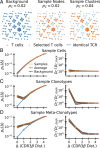Measures of epitope binding degeneracy from T cell receptor repertoires
- PMID: 36649423
- PMCID: PMC9942805
- DOI: 10.1073/pnas.2213264120
Measures of epitope binding degeneracy from T cell receptor repertoires
Abstract
Adaptive immunity is driven by specific binding of hypervariable receptors to diverse molecular targets. The sequence diversity of receptors and targets are both individually known but because multiple receptors can recognize the same target, a measure of the effective "functional" diversity of the human immune system has remained elusive. Here, we show that sequence near-coincidences within T cell receptors that bind specific epitopes provide a new window into this problem and allow the quantification of how binding probability covaries with sequence. We find that near-coincidence statistics within epitope-specific repertoires imply a measure of binding degeneracy to amino acid changes in receptor sequence that is consistent across disparate experiments. Paired data on both chains of the heterodimeric receptor are particularly revealing since simultaneous near-coincidences are rare and we show how they can be exploited to estimate the number of epitope responses that created the memory compartment. In addition, we find that paired-chain coincidences are strongly suppressed across donors with different human leukocyte antigens, evidence for a central role of antigen-driven selection in making paired chain receptors public. These results demonstrate the power of coincidence analysis to reveal the sequence determinants of epitope binding in receptor repertoires.
Keywords: T cells; receptor-ligand binding; repertoire sequencing; specificity.
Conflict of interest statement
The authors declare no competing interest.
Figures







References
-
- Davis M. M., Bjorkman P. J., The T cell receptor genes and T cell recognition. Nature 334, 395 (1988). - PubMed
-
- Emerson R. O., et al. , Immunosequencing identifies signatures of cytomegalovirus exposure history and HLA-mediated effects on the T cell repertoire. Nat. Genet. 49, 659–665 (2017). - PubMed
-
- Bradley P., Thomas P. G., Using T cell receptor repertoires to understand the principles of adaptive immune recognition. Ann. Rev. Immunol. 37, 547–70 (2019). - PubMed
Publication types
MeSH terms
Substances
LinkOut - more resources
Full Text Sources

